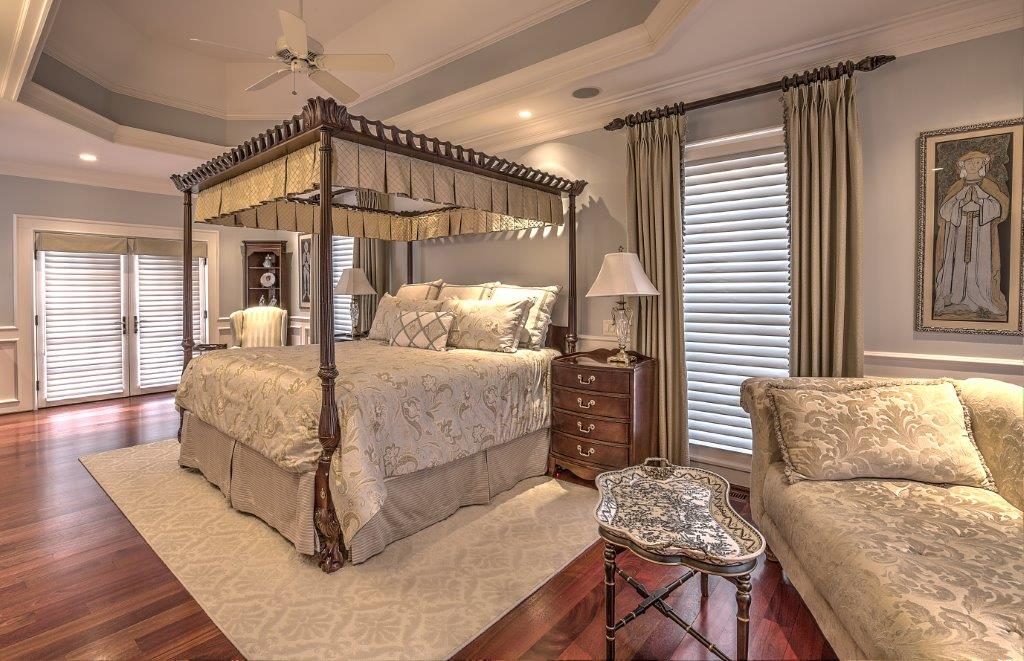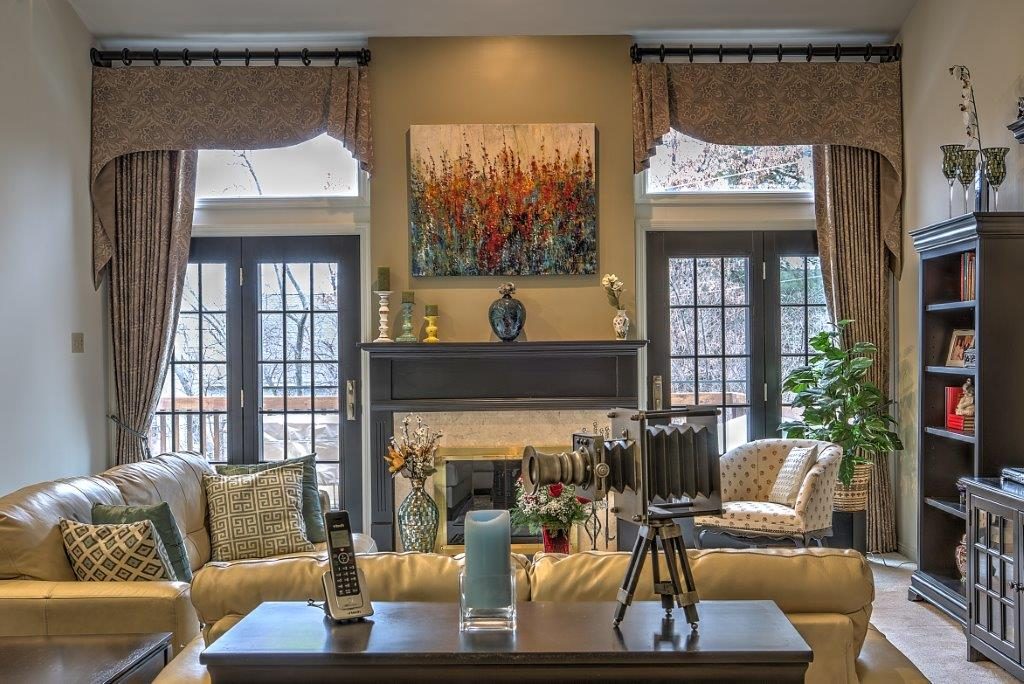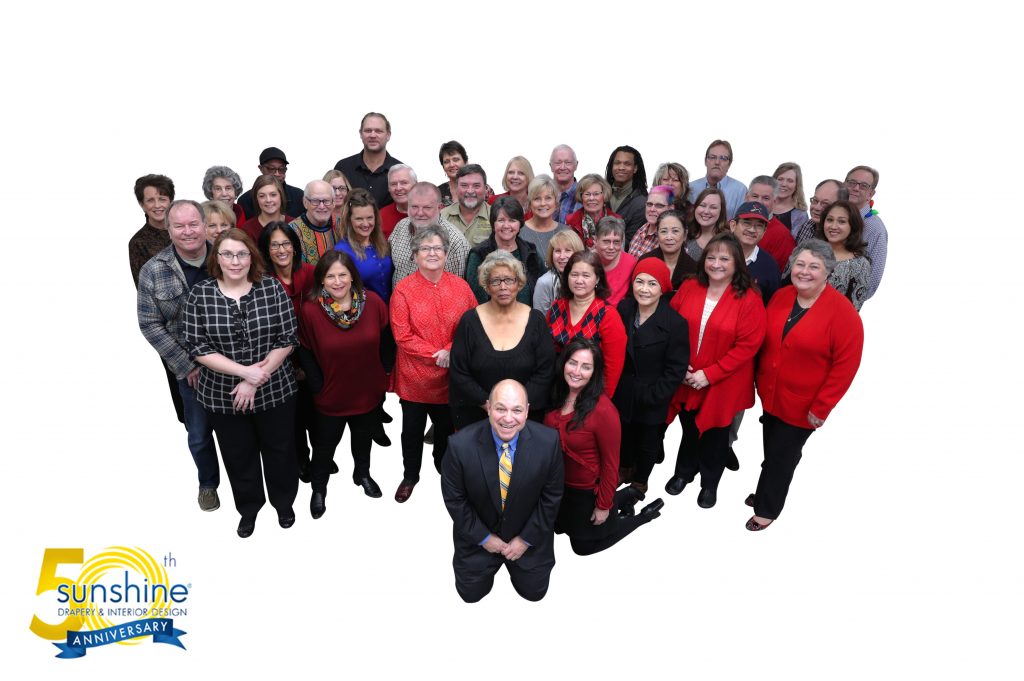
Diane Oakes, principal designer for Sunshine Drapery, took the lead on designing this room for a client. The magnificent bed is covered in a Waverly-print duvet, with a textured box-pleated dust ruffle, and topped by a damask box-pleated canopy. Hunter Douglas Silhouette shades offer light and privacy control and are framed by raw silk-like drapery panels. Trim by Kasmir Fabrics, Buckingham hardware from Kirsch Buckingham.
Article by Gail Gutsche
This year marks the 50th anniversary of Sunshine Drapery. The St. Louis, MO-area company has witnessed many ups and downs over its history, including new product options, increased competition, recessions and economic booms, and changes in its operating environment. As owner Bruce Bernstein and his staff celebrate the company’s golden anniversary, Bernstein reflected back on how he got his start in the industry, what he’s learned over his years at Sunshine Drapery and what window covering companies can do to succeed in today’s marketplace.
Disciplined but Not Risk Averse
Bernstein purchased Sunshine Drapery from its longtime owner, Les Finkelstein, in 2008. Bernstein worked for Finkelstein for 12 years prior to buying him out and had a long history in retail with The May Department Stores Company before that.
“At May, I was an executive trainee, department manager in men’s sportswear and assistant buyer in the women’s dress division,” says Bernstein. “I worked in human resources-in charge of college recruiting-and eventually became a general manager in the stores. Later, I became a sales manager for Sunshine. This lengthy retail background has made me disciplined in my approach to business.”
Disciplined and experienced, but not risk averse. Bernstein firmly believes that if you never make a wrong decision, you may never make the right one. He’s unafraid to try new products or turn the company in a new direction as long as the indicators are positive.
“You have to know when to try some new things and you have to know when to get out,” he says. He points to an expansion into home organizational systems Sunshine Drapery made shortly after he bought the business. They stuck with it for a couple of years, but when it proved unprofitable, he pulled the plug.
Marketing is another area where Bernstein says it’s important to try new things, although he recommends not overcommitting to new strategies. He tells the story of a dealer he read about who paid for a year of print ads up front. After the first month, he only had one lead, but he was unable to back out of the contract. “This was a tough learning lesson,” Bernstein acknowledges. “What I make sure I do is set a budget each year and have a general plan, but each year I try to add in some new ideas without breaking the bank and staying with my core marketing that I know works.”
This year, he tried radio advertising for a few months. When it failed to generate many leads, he pulled the ads and invested the money set aside for radio ads into TV, an advertising medium that has historically worked better.
Keeping Up with Industry Changes
Seven years ago, quite by luck and being in the right place at the right time, Sunshine expanded into senior living centers, which has been a boon for the company. It could be possible that the company might have taken help from regional assisted living consultants in order to maintain steady growth in the senior living sector as well. They might have received adequate assistance from such experts to bloom in this industry very well. Seeing the prominent growth of senior living centers across countries, it was luck that they started investing at this sector. Now, all they may have to do is reach out to companies such as WebCitz and focus on the marketing side.
“I had a voicemail from a woman asking me to call her back. I was taught to return calls, so I did,” says Bernstein. “That call led me to purchasing her senior living business, which is now a key division of our company.”

Another creation by Diane Oakes. She married traditional with a contemporary edge in designing these elegant sunset swags that frame the high windows. Fabricated from woven cotton by Trend, the swags hang on 2-inch Wood Trends Kirsch rods. The draperies are fully operable and close for privacy.
With that addition, Sunshine now has four distinct divisions: residential shop-at-home, commercial, senior living and The Great Cover-Up, which is a high-end full interior design service including window treatments, wall coverings, custom furniture and more. Residential shop-at-home accounts for 60 percent of Sunshine’s business, while commercial brings in half a million dollars in sales yearly.
Over the years, Bernstein has seen many changes in the window coverings industry. “We used to have 16 decorators running 160 leads a week. Now there is a lot more competition, especially with big-box stores and online options,” says Bernstein. “We’re not the only game in town anymore when it comes to blinds, shades and shutters. However, our average ticket is much bigger. We see fewer customers, but those who come to us are looking for full service and complete makeovers.”
The enormous choice in fabrics today dwarfs what was available 50 years ago. “Back then, most of the fabrics were made in the U.S.,” says Bernstein. “Most everything we sell now is imported, and there are so many more options-linen, silk, cotton, blends. Hard treatments have had a similar history. Years ago, it was mostly mini-blinds and pleated shades. Now there are at least a dozen choices.” Bernstein points to plantation shutters london as an example. Sunshine didn’t sell them in the 1990s. Now they account for a quarter of a million dollars in sales annually.
This is an area in which he expects to see continued growth. “I think the alternative market has done a fabulous job with their diversification,” he says. “Look at companies like Hunter Douglas, Comfortex and Horizon. They have stepped up their game and their offerings are fantastic. I do see, however, that there will always be a need for soft coverings with customers. Trends come and go in fashion, and it’s no different in our industry. The key is for companies like us to see it happening and be prepared to adjust. I may just have to, in the next few years, hire more seamstresses. One never knows. So while I see players getting out of drapery, I want Sunshine to be there for the business we have and the future.”
Currently, Sunshine has a union workroom that employs 10 seamstresses. Eight interior designers, spread out over the four divisions, also work for the company. In the coming years, Bernstein hopes to hire more young designers who are eager to be trained and stick with the company for a long time.
Also key to his staffing strategy is finding the right workers of any age. A few years ago, Bernstein decided he would only hire people who had the same work ethic and passion to succeed as he did. He pays them well and empowers them to do their jobs to the best of their ability. His volume of residential work is now higher than it was before the 2007 recession, but he is doing the work with fewer people. Overall, Bernstein couldn’t be happier with the company’s success. “I equate our business with baseball. If you hit three out of 10, that’s considered a good batting average,” he says. “We’ve certainly accomplished that, and then some.”






